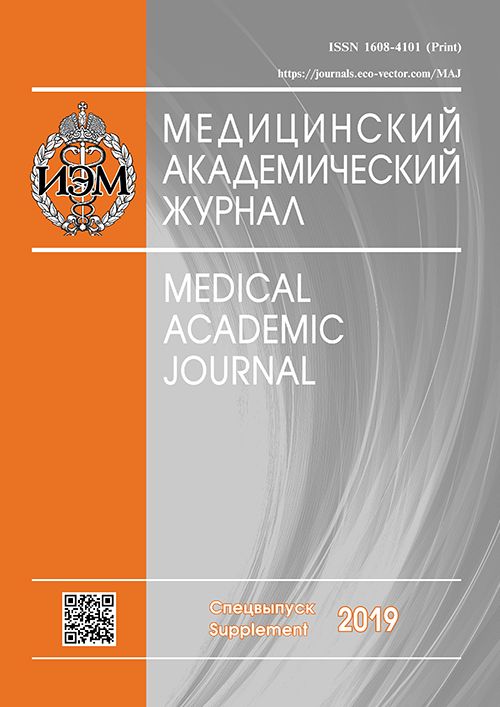HUMAN BETA-DEFENSIN-3 GENE EXPRESSION IN THE NASAL AND SINONASAL MUCOSA
- Authors: Tyrnova EV1
-
Affiliations:
- Saint Petersburg Research Institute of Ear, Nose, Throat and Speech, Saint Petersburg
- Issue: Vol 19, No 1S (2019)
- Pages: 184-186
- Section: Articles
- Published: 15.12.2019
- URL: https://journals.eco-vector.com/MAJ/article/view/19390
- ID: 19390
Cite item
Abstract
Sensitive receptors of the olfactory sensory system are located in the nasal cavity mucosa. The aim of this study was to evaluate the human beta-defensin-3 (hBD-3) gene expression in the surface epithelium of the nasal and sinonasal mucosa. Surgical samples from patients with nasal and sinonasal disease (n = 85) (sinus maxillaries mucosa, choana polyps, middle nasal passage polyps, sinus maxillaries polyps, inferior turbinate mucosa of hypertrophic rhinitis, inferior turbinate mucosa and the middle nasal passage mucosa as controls) were investigated. Total RNA was extracted and analysed by real-time RT-PCR for hBD-3 as well as beta-actin mRNA.hBD-3 gene expression was detected in all examined anatomical regions in 14.29-33.33% samples at low levels, but it was absent in the hypertrophic inferior turbinate mucosa (Fisher’s exact test, p < 0.05 compared to the middle nasal passage mucosa; p < 0.01, odds ratio (OR) 31.15, 95% confidence interval (CI) 1.53÷633.6 compared to the middle nasal passage polyps). The highest hBD-3 mRNA expression detection frequency was detected in the middle nasal passage polyps (53.84% cases) (p < 0.05, OR 7.00, CI 1.10÷44.63 compared to the sinus maxillaries mucosa). The highest levels of hBD-3 gene expression was detected in the middle nasal passage polyps also (Wilcoxon signed rank test, p < 0.05 compared to the hypertrophic inferior turbinate mucosa). Clinically, inflammatory polyps are found in the middle turbinate in patients with chronic rhinosinusitis but not in the inferior turbinate. In the context of chronic inflammation, apart from direct antimicrobial activity, high concentrations hBD-3 also potentially contributes to epithelial injury and fibrotic remodeling.
Full Text
About the authors
E V Tyrnova
Saint Petersburg Research Institute of Ear, Nose, Throat and Speech, Saint Petersburg
References
- Тырнова Е.В., Алешина Г.М., Янов Ю.К., Кокряков В.Н. Изучение экспрессии гена бета-дефенсина-3 человека в слизистой оболочке верхних дыхательных путей // Рос. оториноларингол. - 2015. - № 2 (75). - С. 77-84.
- Funderburg NT, Jadlowsky JK, Lederman MM, et al. The toll-like receptor 1/2 agonists Pam(3) CSK(4) and human β-defensin-3 differentially induce interleukin-10 and nuclear factor-κB signalling patterns in human monocytes. Immunology. 2011;134:151-160. https://doi.org/10.1111/j.1365-2567.2011.03475.x.
- Hariri BM, Cohen NA. New insights into upper airway innate immunity. Am. J. Rhinol. Allergy. 2016;3:319-323. https://doi.org/10.2500/ajra.2016.30.4360.
- Laudien M, Dressel S, Harder J, Gläser R. Differential expression pattern of antimicrobial peptides in nasal mucosa and secretion. Rhinology. 2011;49(1):107-111. https://doi.org/10.4193/Rhino10.036.
- Seiler F, Bals R, Beisswenger C. Function of Antimicrobial Peptides in Lung Innate Immunity. In: Antimicrobial Peptides. Birkhäuser Advances in Infectious Diseases. Ed. by J. Harder, J.M. Schröder. Springer, Cham; 2016. P. 33-52.
- White LC, Weinberger P, Coulson H, et al. Why sinonasal disease spares the inferior turbinate: An immunohistochemical analysis. Laryngoscope. 2016;126(5):E179-183. https://doi.org/10.1002/lary.25791.
Supplementary files







